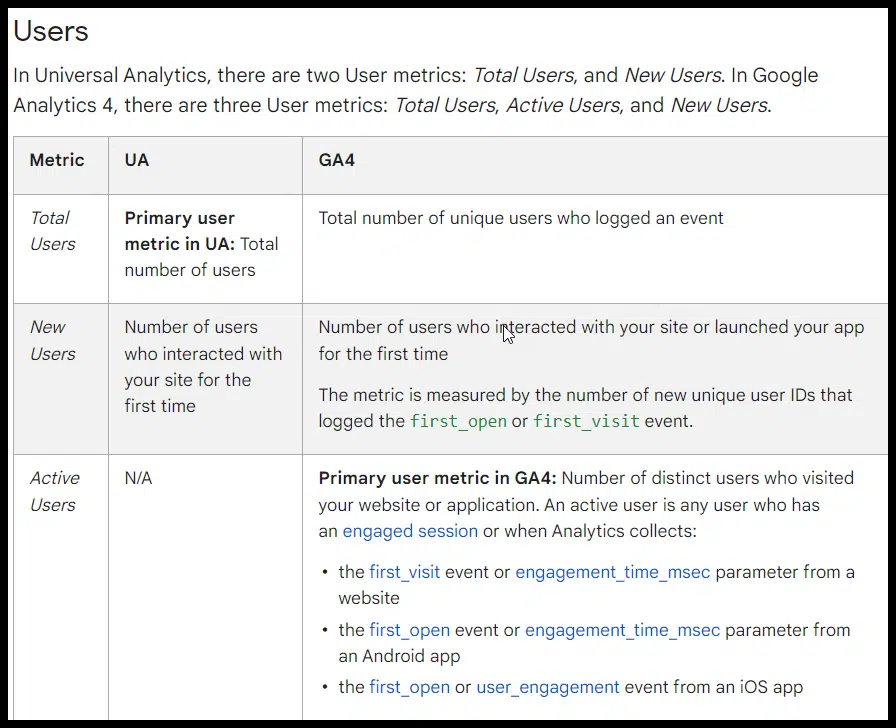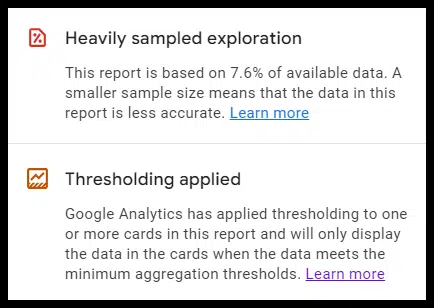6 reasons your GA4 reports aren’t adding up

Sentiment for Google Analytics 4 has not been overwhelmingly positive:
To say the least:
But Universal Analytics (UA) isn’t coming back, so it’s time to figure out how to make GA4 work as well for you as possible.
This article will walk through some of the common issues clients and marketers have run into regarding GA4 reporting and how you can address each.
1. Metric and calculation changes in UA vs. GA4
A fundamental area of confusion for Google Analytics users transitioning from UA to GA4 is that GA4 uses different metrics and calculations than UA.
Adam Proehl does a good job walking through these differences in UA and GA4 metrics in his Search Engine Land article.
Google has also published a breakdown here.
Just the terminology around users, featured at the beginning of that Google documentation, is an area where people get confused as they’re trying to recreate their old UA reports in GA4:

As Proehl summarized, the high-level difference here is:
“UA was based on sessions and pageviews. GA4 is based on events and parameters. Both methods can collect and tally data, but the output in a report will look different.”
Familiarizing yourself with the differences in how things are calculated and what different terminology means and measures is an essential first step to ensuring you aren’t confused by your GA4 reports.
2. Different filters and UI
If you’ve logged into Universal Analytics and GA4, you’ll see major changes to the interface (which, like many aspects of GA4, not everyone loves).
Additionally, there are several different ways to filter data that will deviate from interface to interface.
I’ll use a specific example to demonstrate how you can get tripped up here.
To quickly get at overall organic traffic in Universal Analytics, you could go to Audience > Overview, then segment for organic traffic:

In GA4, getting to a similar quick view of a top-line organic traffic trend may look something like this:

But this is a different metric (first user medium) and a different filter (contains organic – which works for this property but may not for a site with organic social traffic, etc.)
Some of the views or reports you were used to in UA may only be available as “Explorations,” a reporting suite within GA4 that includes:
- Funnel explorations.
- Path explorations.
- “Free form” reports (a replacement for “custom reports” in UA).
This may be your ticket to recreating some of the views and reports you were accustomed to in UA (or at least a close approximation).
Get the daily newsletter search marketers rely on.
3. Data thresholding in GA4

GA4 data may seem to be completely missing or dramatically under-reported in certain views for certain actions (visitors, specific events, etc.) when a user drills down to a specific level.
This is a common point of confusion, particularly for small to medium-sized sites looking at granular levels of data.
According to Google:
“If your report or exploration is missing data, it may be because Google Analytics has applied a data threshold. Data thresholds are applied to prevent anyone viewing a report or exploration from inferring the identity of individual users based on demographics, interests, or other signals present in the data.”
If you want to avoid thresholding, here are your options:
- Disable Google Signals: There are pros and cons to using Signals, but a big con is that it enables this kind of thresholding. The main pros are:
- It will start populating demographic data in GA4.
- It lets you reuse Google Analytics audiences as retargeting audiences in Google Ads (thus, you can show more targeted ads to them).
- Switch to device-only reporting.
- Export data to BigQuery.
4. Data sampling in GA4
While it isn’t new or unique to GA4, data sampling is another factor frequently confusing users. Unlike UA, standard reports in GA4 actually won’t be sampled – which is good news!
Note that standard reports are those in the Reports tab.
However, reports that live within the Explore or Advertising sections of GA4 may be sampled.

This may lead to discrepancies in:
- Standard reports – where you may see larger numbers in GA4 than UA.
- Advanced reports – where sampling is applied in GA4.
The solution for avoiding sampling is to drill down to a more specific time frame (essentially the opposite of thresholding) or upgrade to Google’s paid Analytics 360 product and leverage features.
Sampling and thresholding can be applied within the same reports.
5. API limitations for GA4
There are also changes in how the Google Analytics API can process data with the advent of GA4.
This applies to third-party reporting tools and Google’s own Looker Studio.
Some key limitations to the information you’ll have available in Looker Studio include:
- Only a certain number of rows are available via the API.
- Not all dimensions are available yet, so certain metrics (like exits) may not be available in Looker Studio reports.
- Calculations are slightly different in Looker Studio than GA4, depending on the setup of each account. Looker Studio sometimes has issues with data skewed by multiple filters, for instance.
- For new users, visitors are counted as “new” at midnight, even with the same client ID, which sometimes causes discrepancies.
API quotas are present for any reporting tool, so if your data is in a third-party tool and the GA4 interface isn’t syncing up, this may be the reason.
To help address these issues, there are a few potential workarounds:
- Adjusting your reports so that you’re less likely to hit quota limits.
- Exporting to BigQuery first (which does have its own limitations), then connecting BigQuery to Looker Studio.
- Using a third-party tool that automates the export/import timing to manage quota limits.
Being aware of Looker Studio’s specific limitations and how to recreate reports around those is a good starting point for avoiding confusion and frustration surrounding these reports.
6. Events, goals and historical data
This one is likely a bit more obvious. Still, depending on how they were initially set up and whether you migrated your UA account or events to GA4, you may or may not have events populating in your existing reports.
If your events weren’t migrated over, you’ll want to create new events and goals within GA4 (mainly if these were “hard coded” via UA).
Similarly, while some UA accounts are still recording data, Google is sunsetting UA, and eventually, you’ll be missing data there.
You won’t have GA4 data before it is installed on your site. All this may not occur immediately when you drill into a specific issue in a report.
And if you need to look at UA and GA4 data side by side, go back to the start of the article and keep in mind the differences in metrics and calculations.
Opinions expressed in this article are those of the guest author and not necessarily Search Engine Land. Staff authors are listed here.
Source link : Searchengineland.com





